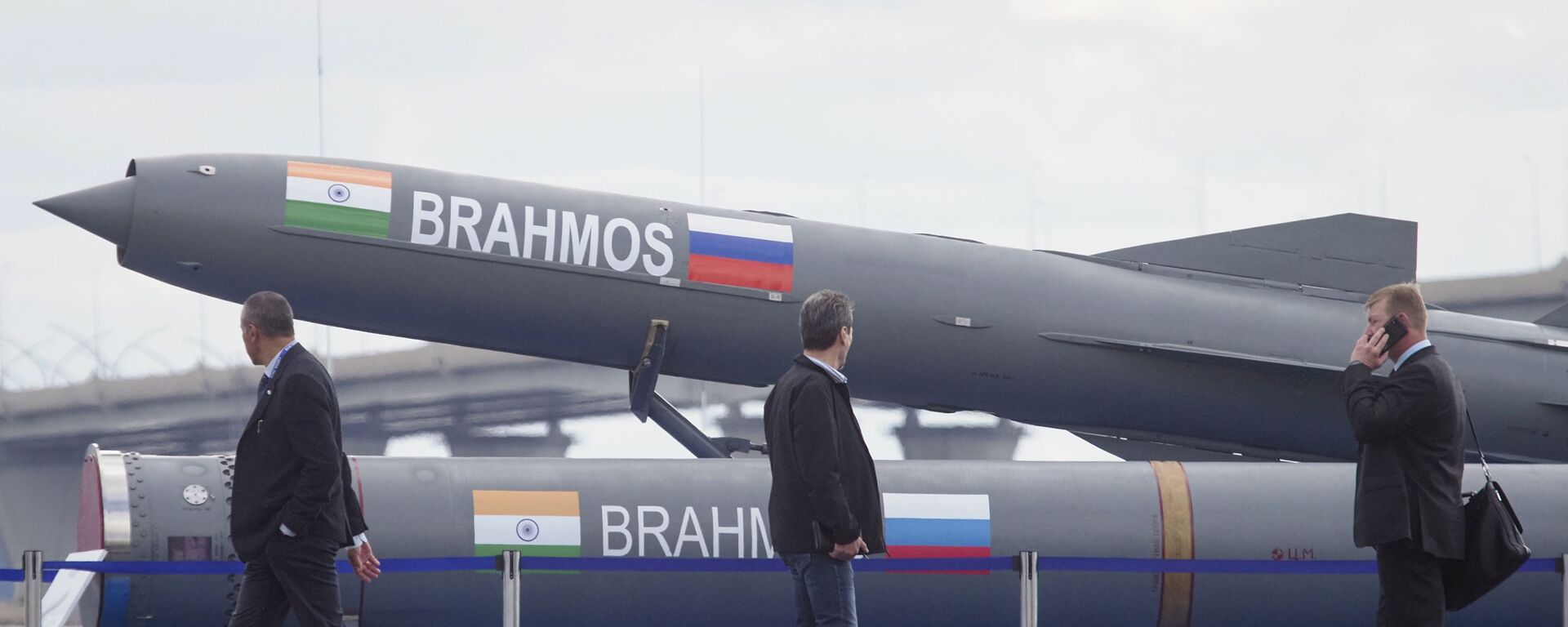https://sputniknews.in/20240530/indias-clampdown-on-defense-export-rules-aimed-to-prevent-afghanistan-like-fiasco-7491512.html
India's Clampdown on Defense Export Rules Aimed to Prevent Afghanistan-Like Fiasco
India's Clampdown on Defense Export Rules Aimed to Prevent Afghanistan-Like Fiasco
Sputnik India
India's decision to introduce stricter guidelines for defense exports is aimed at preventing an Afghanistan-like fiasco, an Indian Military veteran has said.
2024-05-30T20:01+0530
2024-05-30T20:01+0530
2024-05-30T20:21+0530
sputnik opinion
india
afghanistan
ukraine
indian air force (iaf)
ministry of external affairs (mea)
ministry of defence (mod)
defense sector
defense export
arms supplies
https://cdn1.img.sputniknews.in/img/07e7/08/11/3674549_141:0:3640:1968_1920x0_80_0_0_3c28663c6647c843dbed55416ac56f72.jpg
India's decision to introduce stricter guidelines for defense exports aims to prevent an Afghanistan-like fiasco, Group Captain Uttam Kumar Devnath, a former Indian Air Force (IAF) officer told Sputnik India on Thursday.His remarks came in the wake of reports about India's Ministry of Defense (MoD) tightening its grip on end-user rules for exports of military equipment. The decision was taken by the Authority after media reports of Indian arms and ammunition landing in territories, where it wasn't supposed to be found. The government is now putting a strong thrust on ensuring that end-user certification guidelines are followed to the fullest, according to Economic Times this week. This would ensure that Indian weapons don't make their way into unauthorized hands.Previously, some Western reports suggested that Indian artillery shells ended up in Ukraine.However, Indian Ministry of External Affairs (MEA) subsequently stated that the country hadn't supplied the 155mm artillery shells to the East European country.Against this backdrop, Devnath, stressed that India is now exporting military items to over 80 nations, which is expected to breach the $5 billion barrier by 2025-26.India's military platforms are exported to friendly countries and that these nations are expected to use them only for the purpose they have been exported to them, he underlined.At that time, the defense analyst pointed out that India guaranteed both Vietnam and Indonesia that the widely acclaimed supersonic projectile would not be launched against them.These are standard diplomatic maneuvers carried out by arms and ammunition-exporting nations worldwide, according to the expert.Nonetheless, these norms will become much stricter than they were before.Revealing the details of India's military-industrial complex, Devnath mentioned that India has a vast and robust network of defense manufacturing units, including public sector units like the Hindustan Aeronautics Limited (HAL) and over 600 private sector firms engaged in the production of various types of weapons or ammunition.To sell their military products overseas, these firms first seek a NOC (No Objection Certificate) from the MoD, which seeks a similar NOC from the MEA.
https://sputniknews.in/20240429/thirty-five-fold-surge-russias-role-in-the-rise-of-indian-defence-exports-7244539.html
india
afghanistan
ukraine
delhi
new delhi
vietnam
indonesia
the philippines
Sputnik India
feedback.hindi@sputniknews.com
+74956456601
MIA „Rossiya Segodnya“
2024
Pawan Atri
https://cdn1.img.sputniknews.in/img/07e6/0c/13/139630_147:0:831:684_100x100_80_0_0_8fa2b25903e7787fe6a2698552c167df.png
Pawan Atri
https://cdn1.img.sputniknews.in/img/07e6/0c/13/139630_147:0:831:684_100x100_80_0_0_8fa2b25903e7787fe6a2698552c167df.png
News
en_IN
Sputnik India
feedback.hindi@sputniknews.com
+74956456601
MIA „Rossiya Segodnya“
Sputnik India
feedback.hindi@sputniknews.com
+74956456601
MIA „Rossiya Segodnya“
Pawan Atri
https://cdn1.img.sputniknews.in/img/07e6/0c/13/139630_147:0:831:684_100x100_80_0_0_8fa2b25903e7787fe6a2698552c167df.png
export of arms, india defense exports, ministry of defence india, ministry of defense india, indian defense ministry, indonesia brahmos, india indonesia brahmos deal, philippines brahmos, philippines india brahmos deal, vietnam brahmos, defense exports india, india defense export rules, india end-user certificate defense exports,
export of arms, india defense exports, ministry of defence india, ministry of defense india, indian defense ministry, indonesia brahmos, india indonesia brahmos deal, philippines brahmos, philippines india brahmos deal, vietnam brahmos, defense exports india, india defense export rules, india end-user certificate defense exports,
India's Clampdown on Defense Export Rules Aimed to Prevent Afghanistan-Like Fiasco
20:01 30.05.2024 (Updated: 20:21 30.05.2024) India's defense exports broke all previous records in 2023, crossing the $3 billion mark for the first time since independence.
India's decision to introduce stricter guidelines for defense exports aims to prevent an Afghanistan-like fiasco, Group Captain Uttam Kumar Devnath, a former Indian Air Force (IAF) officer told Sputnik India on Thursday.
"In the past, the world has seen US weapons falling into the hands of terrorists in Afghanistan and radical groups in Gaza and that's why, I reckon India's move is a proactive one to prevent Indian weapons from falling into the hands of militant organizations and unfriendly nations," Devnath said.
His remarks came in the wake of reports about India's Ministry of Defense (MoD) tightening its grip on end-user rules for exports of military equipment. The decision was taken by the Authority after media reports of Indian arms and ammunition landing in territories, where it wasn't supposed to be found.
The government is now putting a strong thrust on ensuring that
end-user certification guidelines are followed to the fullest, according to Economic Times this week. This would ensure that Indian weapons don't make their way into unauthorized hands.
Previously, some Western reports suggested that Indian artillery shells ended up in Ukraine.
However, Indian Ministry of External Affairs (MEA) subsequently stated that the country hadn't supplied the 155mm artillery shells to the East European country.
"We have also seen some media reports in this regard. But we can categorically say that we have not sent any of these artillery ammunitions to Ukraine. We have not exported them and we have not sent them," MEA spokesperson Randhir Jaiswal told reporters earlier this year.
Against this backdrop, Devnath, stressed that India is now exporting military items to over 80 nations, which is expected to breach the $5 billion barrier by 2025-26.
India's military platforms are exported to friendly countries and that these nations are expected to use them only for the purpose they
have been exported to them, he underlined.
"For example, when India negotiated an export order for the BrahMos missiles with the Philippines, Vietnam and Indonesia showed their concerns. They told India that it shouldn't happen that the Philippines deploys the BrahMos during a scenario of tensions between the Philippines and either of the two countries," Devnath asserted.
At that time, the defense analyst pointed out that India guaranteed both Vietnam and Indonesia that the widely acclaimed supersonic projectile would not be launched against them.
These are standard diplomatic maneuvers carried out by arms and ammunition-exporting nations worldwide, according to the expert.
"One of the ways to ensure that Indian military exports don't land in unauthorized hands is an end-user certificate. Under this, a friendly country that is acquiring weapons from India promises that it will not use the arms and ammunition procured from the world's largest democratic state against any other nation that is friendly to New Delhi," the geopolitical pundit stated.
Nonetheless, these norms will become much stricter than they were before.
Revealing the details of India's military-industrial complex, Devnath mentioned that India has a vast and robust network of defense manufacturing units,
including public sector units like the Hindustan Aeronautics Limited (HAL) and over 600 private sector firms engaged in the production of various types of weapons or ammunition.
To sell their military products overseas, these firms first seek a NOC (No Objection Certificate) from the MoD, which seeks a similar NOC from the MEA.



